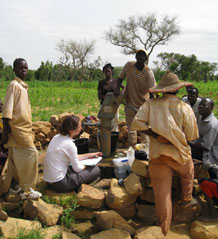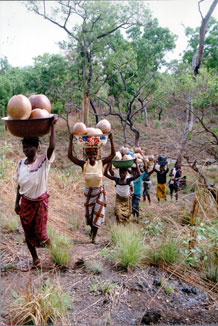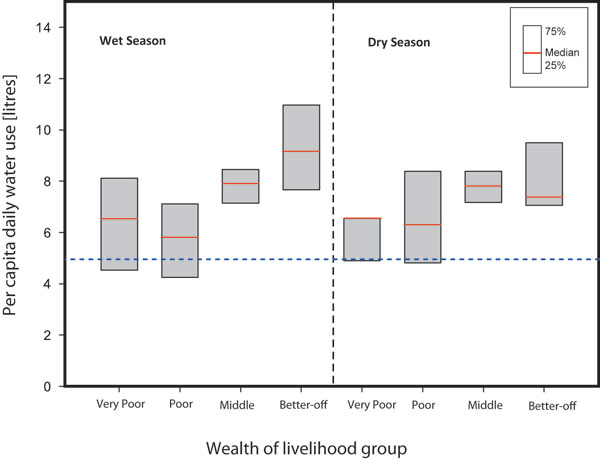Access to improved water supplies and wealth case study
This case study analysed detailed survey data to examine links between water use, water access and wealth in Ethiopia, with a particular focus on how different wealth groups with access to different water sources deal with climate variability.
Water economy for livelihoods (WELS) assessment, Ethiopia

The dataset used in the analysis was collected from January to March 2009, by RiPPLE and the Food Economy Group in eastern Ethiopia (further details in Coulter, 2010).
WELS identifies 'typical' communities within specified livelihood zones, and within these communities selects 'typical' households from three to four wealth groups (categorised as 'better-off', 'middle', 'poor', and in some zones, 'very poor').
Twenty-four communities were assessed from three livelihood zones from rain-fed mixed farming to agropastoralism, on a highland to lowland transect. Within each community data was collected from the different wealth groups.
Results
Detailed analyses of the data show the following:
There is a clear link between wealth and the use of water, with implications for livelihoods.
- Groups that are more wealthy use more water, for all purposes, across all livelihood zones. Differences are especially pronounced in the dry season (See Figure 1). There is evidence that for some income generating activities, poorer households suffer disproportionately when water is scarce.
- The important role of wealth in determining water use is likely to relate to a combination of factors including labour availability (household size declines consistently with wealth) and possibly the availability of water storage and transport assets.
Levels of water use in the case study areas in Ethiopia are low, with no wealth groups abstracting sufficient water for hygiene uses at any time of year.

- Water use for personal hygiene in all zones falls well below even the minimum Sphere standard of 6 litres per capita per day (lpcd), which aims to represent the absolute minimum volume needed to maintain health in emergency situations (Sphere, 2011).
- The overall low level of water use for hygiene may be due to lack of demand rather than lack of available water, but the drop-off in water use for hygiene by poor groups in the dry season suggests that access constraints do come into play and that water use for hygiene is sacrificed when collection times are high and labour short. Ethiopia may not be representative of other parts of Africa.
Collection times increase considerably in the dry season for all sources apart from boreholes and perennial rivers
- Of all source types, boreholes offer the most consistently high quality water and collection times do not significantly increase in the dry season.
- In contrast, collection times from protected springs (the main improved water source found in midland and highland areas of Ethiopia) still increase notably in the long dry season due to falling water tables. Collection times for water generally increase from typical figures of 1–2 hours in the wet season to 2–3 hours in the long dry season of a normal year.
References
Coulter, L, Kebede, S, and Zeleke B. 2010. Water Economy Baseline Report: Water and livelihoods in a highland to lowland transect in eastern Ethiopia. RiPPLE Working Paper 16. RiPPLE, Addis Ababa.
Sphere. 2011. Humanitarian charter and minimum standards in humanitarian response. Practical Action Publishing, Rugby, UK.
Contact
Contact Dr Alan MacDonald or Dan Lapworth for further information







